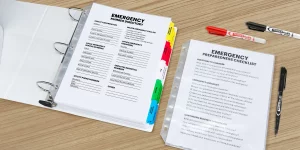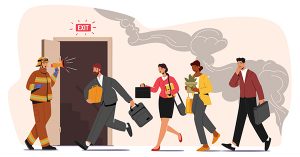Emergencies can happen at any time, typically without any warning. Would you know what to do when an emergency happens at your workplace? It is important to have plans in place ahead of time, so you don’t need to think about what happens next, you only need to act on the pre-approved and practiced plan.

If your facility needs to be evacuated, please leave the area immediately. Make sure you know your evacuation route and choose a meet-up point for all persons in that area/office. DO NOT go back and search for those who are unaccounted for. Also, make sure you check in with your supervisor so they can keep a running count of who has successfully evacuated the building. HR is actively updating these protocols and will send them to all staff when ready.
Injuries, Accidents, and Emergencies in the Workplace
There are first aid kits on hand in every CMC office, and you should know where they are located. If you do not, we recommend you inquire with your supervisor. Some workplaces have automated external defibrillators, (AEDs). If your workplace has one it is important to know where they are kept, and who in the office has been trained to operate it.
Here are some general best practices for office safety:
- If you fear someone’s life is in danger, call 911.
- If you are certified in first aid and feel comfortable correctly performing those services, you can fill in until paramedics arrive.
- If someone has a fall, spinal or head injury, do not move them unless they are in danger.
- If a co-worker is choking, follow the instructions for the Heimlich Maneuver. This is good to know for life in general, if you’ve never seen how this is done please click the link.
Fire Safety and Best Practices
In the case you are the first one in your workplace to see smoke or fire, make sure you tell someone, pull the fire alarm, and follow your company’s protocols for notifying fire and emergency services. Do not try and fight the fire unless the fire is contained in a very small area. CMC provides fire extinguishers in common areas and near lunchroom areas, but they are for emergency use only.
Chemical Exposures
If your job requires you to work with chemicals be sure you know your employer’s guidelines for handling these chemicals and any protocols in the event of a chemical spill or other hazard. If you think someone has had chemical overexposure, the first step should be to contact the poison control center and/or 911 (depending on the severity and type of overexposure).
Four key areas for overexposure are the:
- Eyes
- Inhalation to the respiratory system
- Ingesting or swallowing a poison
- Skin contact or other topical chemical burns
Again, emergencies happen when you least expect them. Being prepared and knowing how to handle these situations can mean the difference between life and death for you and your co-workers. For more information check out ready.gov for how best to prepare in the event of an emergency.

